Large-scale reorganization in the somatosensory cortex and thalamus after sensory loss in macaque monkeys
- PMID: 18945912
- PMCID: PMC2613515
- DOI: 10.1523/JNEUROSCI.2334-08.2008
Large-scale reorganization in the somatosensory cortex and thalamus after sensory loss in macaque monkeys
Abstract
Adult brains undergo large-scale plastic changes after peripheral and central injuries. Although it has been shown that both the cortical and thalamic representations can reorganize, uncertainties exist regarding the extent, nature, and time course of changes at each level. We have determined how cortical representations in the somatosensory area 3b and the ventroposterior (VP) nucleus of thalamus are affected by long standing unilateral dorsal column lesions at cervical levels in macaque monkeys. In monkeys with recovery periods of 22-23 months, the intact face inputs expanded into the deafferented hand region of area 3b after complete or partial lesions of the dorsal columns. The expansion of the face region could extend all the way medially into the leg and foot representations. In the same monkeys, similar expansions of the face representation take place in the VP nucleus of the thalamus, indicating that both these processing levels undergo similar reorganizations. The receptive fields of the expanded representations were similar in somatosensory cortex and thalamus. In two monkeys, we determined the extent of the brain reorganization immediately after dorsal column lesions. In these monkeys, the deafferented regions of area 3b and the VP nucleus became unresponsive to the peripheral touch immediately after the lesion. No reorganization was seen in the cortex or the VP nucleus. A comparison of the extents of deafferentation across the monkeys shows that even if the dorsal column lesion is partial, preserving most of the hand representation, it is sufficient to induce an expansion of the face representation.
Figures






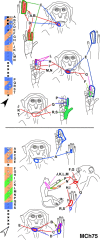
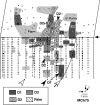
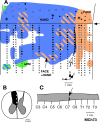
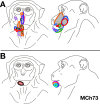
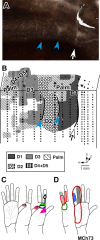

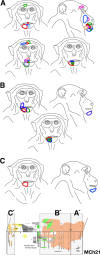

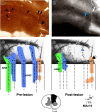

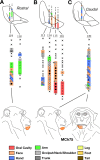
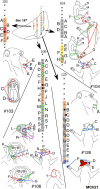


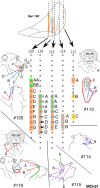
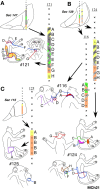
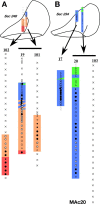
Similar articles
-
Intracortical and Thalamocortical Connections of the Hand and Face Representations in Somatosensory Area 3b of Macaque Monkeys and Effects of Chronic Spinal Cord Injuries.J Neurosci. 2015 Sep 30;35(39):13475-86. doi: 10.1523/JNEUROSCI.2069-15.2015. J Neurosci. 2015. PMID: 26424892 Free PMC article.
-
Sensory enrichment after peripheral nerve injury restores cortical, not thalamic, receptive field organization.Eur J Neurosci. 2001 May;13(9):1755-66. doi: 10.1046/j.0953-816x.2001.01555.x. Eur J Neurosci. 2001. PMID: 11359527
-
Large-scale reorganization of the somatosensory cortex following spinal cord injuries is due to brainstem plasticity.Nat Commun. 2014 Apr 8;5:3602. doi: 10.1038/ncomms4602. Nat Commun. 2014. PMID: 24710038
-
Altered Expression of Reorganized Inputs as They Ascend From the Cuneate Nucleus to Cortical Area 3b in Monkeys With Long-Term Spinal Cord Injuries.Cereb Cortex. 2018 Nov 1;28(11):3922-3938. doi: 10.1093/cercor/bhx256. Cereb Cortex. 2018. PMID: 29045569
-
Cortical and subcortical plasticity in the brains of humans, primates, and rats after damage to sensory afferents in the dorsal columns of the spinal cord.Exp Neurol. 2008 Feb;209(2):407-16. doi: 10.1016/j.expneurol.2007.06.014. Epub 2007 Jul 6. Exp Neurol. 2008. PMID: 17692844 Free PMC article. Review.
Cited by
-
Reorganization of Higher-Order Somatosensory Cortex After Sensory Loss from Hand in Squirrel Monkeys.Cereb Cortex. 2019 Sep 13;29(10):4347-4365. doi: 10.1093/cercor/bhy317. Cereb Cortex. 2019. PMID: 30590401 Free PMC article.
-
Multimodal Evaluation of TMS - Induced Somatosensory Plasticity and Behavioral Recovery in Rats With Contusion Spinal Cord Injury.Front Neurosci. 2019 Apr 24;13:387. doi: 10.3389/fnins.2019.00387. eCollection 2019. Front Neurosci. 2019. PMID: 31068784 Free PMC article.
-
Model-based parcellation of diffusion MRI of injured spinal cord predicts hand use impairment and recovery in squirrel monkeys.Behav Brain Res. 2024 Feb 29;459:114808. doi: 10.1016/j.bbr.2023.114808. Epub 2023 Dec 10. Behav Brain Res. 2024. PMID: 38081518 Free PMC article.
-
Passive exercise of the hind limbs after complete thoracic transection of the spinal cord promotes cortical reorganization.PLoS One. 2013;8(1):e54350. doi: 10.1371/journal.pone.0054350. Epub 2013 Jan 22. PLoS One. 2013. PMID: 23349859 Free PMC article.
-
Welcome biological breakthroughs, supply psychosocial insights.Mens Sana Monogr. 2014 Jan;12(1):79-91. doi: 10.4103/0973-1229.130315. Mens Sana Monogr. 2014. PMID: 24891799 Free PMC article.
References
-
- Calford MB, Tweedale R. Immediate and chronic changes in responses of somatosensory cortex in adult flying-fox after digit amputation. Nature. 1988;332:446–448. - PubMed
-
- Calford MB, Tweedale R. Immediate expansion of receptive fields of neurons in area 3b of macaque monkeys after digit denervation. Somatosens Mot Res. 1991;8:249–260. - PubMed
-
- Chen R, Cohen LG, Hallett M. Nervous system reorganization following injury. Neuroscience. 2002;111:761–773. - PubMed
-
- Condés-Lara M, Barrios FA, Romo JR, Rojas R, Salgado P, Sánchez-Cortazar J. Brain somatic representation of phantom and intact limb: a fMRI study case report. Eur J Pain. 2000;4:239–245. - PubMed
-
- Darian-Smith C, Brown S. Functional changes at periphery and cortex following dorsal root lesions in adult monkeys. Nat Neurosci. 2000;3:476–481. - PubMed
Publication types
MeSH terms
Grants and funding
LinkOut - more resources
Full Text Sources
